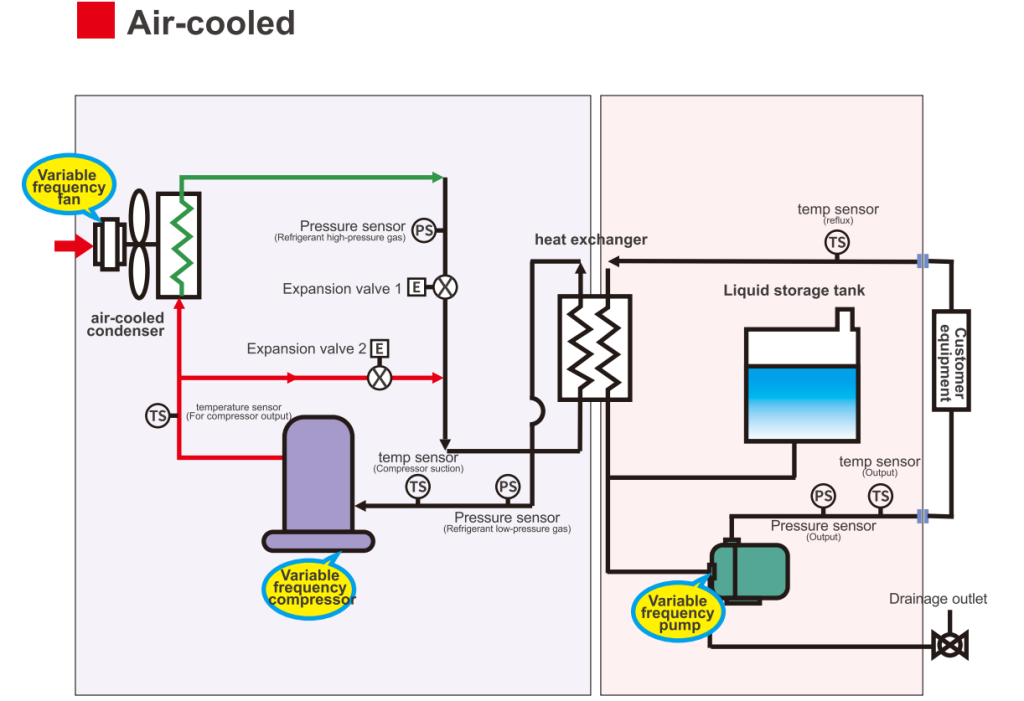What is an Air-Cooled Chiller

- Compression Chillers vs Absorption Chillers Key Differences Efficiency and Applications
- What Are the Common Types of Chiller Compressors
- Hidden Costs of Chillers Quotes
- Industrial Chiller vs Industrial Freezer
- What Are Water-Cooled Condensers
- Custom Chiller vs Standard Chiller
- Qu'est-ce qu'un refroidisseur à air ?
- Qu'est-ce qu'un refroidisseur à eau ?
- août 2025
- juillet 2025
- juin 2025
- mai 2025
- mars 2025
- février 2025
- janvier 2025
- décembre 2024
- novembre 2024
- octobre 2024
- septembre 2024
- août 2024
- juillet 2024
- juin 2024
- mai 2024
- avril 2024
- mars 2024
- février 2024
- septembre 2023
- juillet 2023
- juin 2023
- mai 2023
- janvier 2023
refroidisseur à air refroidisseur Installation d'un refroidisseur refroidisseurs Assemblage froid Congélateur refroidisseur d'eau refroidissement chauffage circulateur système de refroidissement et de chauffage système de refroidissement Réacteur en verre double couche système de contrôle dynamique de la température congélateur refroidisseur de gaz circulateur de chauffage refroidisseur industriel refroidissement industriel congélateur industriel réfrigérateur industriel réacteur à double enveloppe refroidisseur de liquide refroidisseur à basse température nouvelles refroidisseur pharmaceutique refroidisseur de processus refroidisseur de réacteur refroidissement du réacteur refroidissement du réacteur chauffage chauffage du réacteur refroidissement système de réacteur circulateur réfrigéré refroidisseur de réfrigération refroidisseur à vis refroidisseur de semi-conducteurs refroidisseur pour tests de semi-conducteurs sundi tcu contrôle de la température chambre de test thermostat refroidisseur à ultra basse température refroidisseur pour essais de véhicules refroidisseur d'eau refroidisseur à eau wtd
Chillers are typically divided into two categories based on how they handle condensation: refroidisseurs à air and water-cooled chillers. In our earlier article Qu'est-ce qu'un refroidisseur à eau ?, we explained how those systems use cooling water to remove heat from the refrigerant. But what about air-cooled systems? How do they get the job done, and what are their advantages and limitations?
What is an Air-Cooled Chiller?
An air-cooled chiller is an industrial cooling system. The term “air-cooled” comes from the way it works—by relying on fans to blow air across the condenser to cool it down.
To make this easier to picture, think of how a household air conditioner works. The indoor unit (the evaporator) is where the refrigerant evaporates and absorbs heat, cooling the warm air inside the room.
The outdoor unit (the condenser) uses fan blades to draw in natural airflow and push it across the coils, helping release heat from the high-temperature refrigerant. Air-cooled chillers operate on the same principle, just on a larger industrial scale.


Benefits of Air-Cooled Chillers
Lower Initial Investment
Budgets often dictate equipment choices, and that’s where air-cooled systems stand out. Compared with water-cooled chillers, the initial investment is much lower. Why?
Because you don’t need complex piping or massive cooling towers—just fans at the condenser. For many small to medium-sized projects, this cost advantage makes air-cooled chillers a clear winner.
Simple Installation and Maintenance
With air-cooled chillers, there’s no need to worry about water quality or designing a complicated piping layout. You can install the unit anywhere with decent airflow. Maintenance is also straightforward and inexpensive.
Day-to-day care usually comes down to checking the fan blades and cleaning filters. Even without a specialized maintenance team, anyone with basic training can handle it.
No Water Limitations
Water-cooled chillers require reliable water sources with specific quality standards, which isn’t always practical. Air-cooled chillers, on the other hand, work entirely with air. That means no water costs, no water treatment concerns, and no worries about supply. This makes them an ideal solution in areas where water is scarce or where water quality isn’t dependable.


Limitations of Air-Cooled Chillers
Sensitive to Environmental Conditions
Compared with water-cooled chillers, air-cooled systems are much more affected by their surroundings. Because they rely on air to remove heat from the réfrigérant, high outdoor temperatures can reduce heat transfer efficiency.
The system has to work harder to maintain cooling performance, which increases energy consumption—and that shows up in higher electricity bills.
Noise Levels
Large fans are essential for moving air across the condenser coils, but they come with one drawback: noise. The constant hum and buzzing of fan operation can disrupt work or living environments. In settings where quiet operation is critical, like cleanrooms or laboratories, water-cooled chillers are often the preferred choice.
Space Requirements
At first glance, it’s easy to think water-cooled systems take up more room, since they need cooling towers and piping. But if you look at the chiller unit alone, air-cooled systems are actually bulkier. They require larger fans and coils to effectively cool the refrigerant, which makes the unit itself occupy more space.
On top of that, proper installation requires open, well-ventilated areas with enough clearance for heat to escape. If you’re considering placing a chiller in a basement, stairwell, or other confined space, a water-cooled unit might be a more practical fit.
Conclusion
For small projects with limited budgets, air-cooled chillers strike a good balance between price and performance. If you’re planning a new project or thinking about upgrading an existing cooling system, LNEYA proudly offers a full range of refroidisseurs à air as well as fully customized solutions.
Contact us today to learn how LNEYA can support your cooling needs.
Refroidisseurs associés
CONTACTEZ-NOUS
TEL:
EMAIL:
WeChat et WhatsApp:

Wechat QR

Vous avez une question ou besoin d'un devis ? Remplissez le formulaire ci-dessous et notre équipe vous répondra sous 24 heures.
 LNEYA Industrial Chillers Fabricant Fournisseur
LNEYA Industrial Chillers Fabricant Fournisseur
















